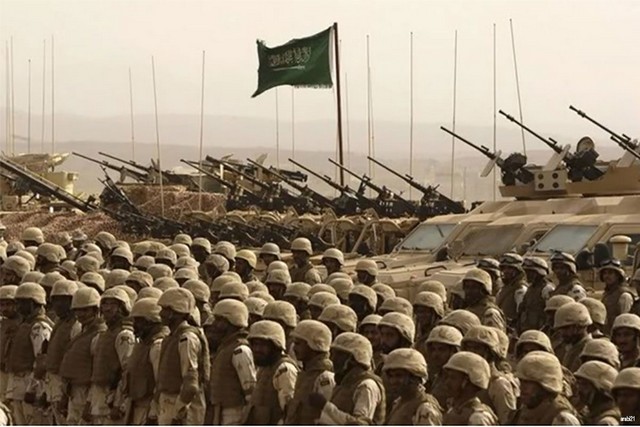By Patrick Martin
The Saudi-led coalition which has invaded Yemen over the past two months is now poised to make a direct assault on the country’s capital city, Sanaa, according to press reports Sunday. An estimated 12,000 troops launched an offensive in Marib province, directly east of the capital.
The coalition is nominally led by exiled Yemeni president Abdrabu Mansur Hadi, who was driven from the country earlier this year by Shiite Houthi rebels and forces loyal to the former longtime ruler Ali Abdullah Saleh.
Yemeni army brigadier general Murad Turaiq, commander of the pro-Hadi forces in Marib province allied with the Saudi-led invaders, declared, “This battle is not a battle for Marib, rather it is the battle for Sanaa.”
Turaiq did not attempt to disguise the leading role of the foreign forces, telling the press that troops from Saudi Arabia and the UAE were spearheading the offensive against the Houthi-held positions.
Press reports said the attackers were equipped with US-supplied Apache helicopter gunships and armored vehicles, underscoring the key role of the Obama administration in underwriting and authorizing the latest Middle East bloodbath.
There were accounts of troop reinforcements passing through the Wadia border crossing from Saudi Arabia into Yemen in preparation for the latest offensive. The latest large contingent of foreign troops was 1,000 from Qatar, including armored vehicles and helicopter gunships, and arrived last week.
At least 5,000 people have been killed in fighting in Yemen this year, and millions have been displaced from their homes. One humanitarian agency estimated that 80 percent of the population, more than 20 million people, is now in need of some form of aid, including food, shelter and drinking water.
Saudi and UAE warplanes carried out bombing raids against both Marib province and many targets in Saana over the weekend. The city of two million people has been devastated by repeated attacks by the Saudi-led coalition, which enjoys uncontested control of the airspace over Yemen. At least seven civilians were reported killed Saturday in Sanaa, and another 16 across the country, according to preliminary press accounts.
The civil war in Yemen pits the Houthis and forces loyal to Saleh, who ruled the country for three decades until 2012, against a coalition of reactionary Sunni monarchies, led by Saudi Arabia and including the Gulf sheikdoms of Bahrain, Kuwait, Qatar and the UAE, as well as Jordan, Morocco, Egypt and Sudan.
The Sunni monarchies portray the Houthis as pawns of Iran, although Iranian support is quite limited and played little role in the offensive which ousted the widely unpopular Hadi regime.
The Hadi government was driven out of Sanaa last fall, fleeing to the southern port city of Aden, then leaving the country entirely and seeking refuge in Saudi Arabia after the rebel forces captured Aden in February. A Saudi-led air war began in March and had little apparent effect on the Houthis’ position, though it destroyed much of the impoverished country’s infrastructure.
The entry of ground forces from the Persian Gulf states, beginning in July, has thrown back the Houthi forces from southern Yemen, with a ragged battle line now running from Taiz, on the Red Sea, east and north around Sanaa and ending at the Houthi stronghold of Sadaa, the northernmost portion of the country.
In addition to the main battle east of Sanaa, there was renewed fighting around Taiz over the weekend, as Houthi rebels sought to improve their position in the divided city, where pro-Hadi forces held government buildings in the city center.
Acting under orders from its Saudi patrons, the Hadi government-in-exile announced Sunday that it would not attend UN-mediated peace talks with the Houthis, which had been schedule to begin this week. An official spokesman said the Houthis must first comply with UN Security Council Resolution 2216, adopted in April, which requires their effective capitulation—recognition of Hadi as president and withdrawal from Sanaa, Taiz and other major cities.
The humanitarian group Oxfam said Friday that British weapons supplied to the Saudi-led forces were escalating the crisis and might be in breach of laws prohibiting arms sales to conflict zones. The weapons include cluster bombs, sold to Saudi Arabia, which have been used against civilian areas in the Houthi-controlled zone, according to a report released September 3 by the Cluster Munition Coalition, which seeks to ban the devices.
A key ally of the Saudi-led, US-backed anti-Houthi coalition is Al Qaeda in the Arabian Peninsula (AQAP), which now controls much of Hadhramaut province, a huge desert area in eastern Yemen, including the port city of Mukalla. This remarkable arrangement starkly underscores the cynical character of the US claims to be fighting “terrorism” in the Middle East.
An unusually frank article in the Wall Street Journal, published September 10, asked the question, “Is Al Qaeda Winning in Saudi-Iran Proxy War in Yemen?” Writing from Yemen, correspondent Yaroslav Trofimov noted, “Few here deny that al Qaeda has fought alongside the broad alliance that ousted pro-Iran Houthi militias from much of southern Yemen in recent weeks… UAE and Saudi forces in Yemen have maintained an informal nonaggression pact with al Qaeda, abstaining from hitting each other, coalition officials say.”
US and Saudi officials undoubtedly discussed the issue of AQAP when King Salman visited Washington last week and held talks with President Obama at the White House on both Yemen and the Iran nuclear arms deal. Following this meeting, the US carried out drone strikes against alleged AQAP targets in Yemen, reportedly killing at least five fighters on the night of September 12, according to local security officials.
14 September, 2015
WSWS.org

